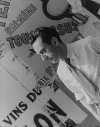 Radnitzky was a photographer, painter, and filmmaker better known in the art world as Man Ray. After forming the New York Dada group with Marcel Duchamp in 1917, he moved to Paris and became associated with the Surrealists. By placing objects on light-sensitive paper and exposing them to sunlight, he created “cameraless” pictures called “rayographs.” He later turned to portrait and fashion photography, extensively documenting Parisian celebrities. How did Radnitzky come to be known as Man Ray? Discuss
Radnitzky was a photographer, painter, and filmmaker better known in the art world as Man Ray. After forming the New York Dada group with Marcel Duchamp in 1917, he moved to Paris and became associated with the Surrealists. By placing objects on light-sensitive paper and exposing them to sunlight, he created “cameraless” pictures called “rayographs.” He later turned to portrait and fashion photography, extensively documenting Parisian celebrities. How did Radnitzky come to be known as Man Ray? Discuss
Source: The Free Dictionary
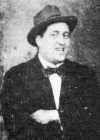 Apollinaire was a French poet who developed a casual, lyrical poetic style characterized by a blend of modern and traditional images and verse techniques. His poetry was marked by daring technical experiments, and his use of unusual verbal associations and word patterns to create surprise is often considered the start of Surrealism. A friend of many avant-garde artists, including Pablo Picasso, Apollinaire was once arrested as a suspect in the theft of what famous painting?
Apollinaire was a French poet who developed a casual, lyrical poetic style characterized by a blend of modern and traditional images and verse techniques. His poetry was marked by daring technical experiments, and his use of unusual verbal associations and word patterns to create surprise is often considered the start of Surrealism. A friend of many avant-garde artists, including Pablo Picasso, Apollinaire was once arrested as a suspect in the theft of what famous painting? 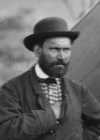 Pinkerton, an American detective and spy, founded the first private detective agency in the US—the Pinkerton Detective Agency—in 1850. The agency, which specialized in railroad theft cases, soon became famous, and Pinkerton opened branches in several cities. In 1860, he discovered and thwarted a plot to assassinate newly elected President Abraham Lincoln while en route to his inauguration. He went on to serve as a spy during the Civil War and head up what would become what government agency?
Pinkerton, an American detective and spy, founded the first private detective agency in the US—the Pinkerton Detective Agency—in 1850. The agency, which specialized in railroad theft cases, soon became famous, and Pinkerton opened branches in several cities. In 1860, he discovered and thwarted a plot to assassinate newly elected President Abraham Lincoln while en route to his inauguration. He went on to serve as a spy during the Civil War and head up what would become what government agency? 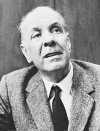 Borges was an Argentine poet, essayist, and short-story writer. Much of his work is rich in fantasy and metaphorical allegory, including the story collection Ficciones, which won him an international following. In the 1920s, Borges was afflicted by a worsening hereditary blindness and was totally blind by the mid-1950s. Forced to abandon the writing of long texts, he began dictating his works. What literary movement is Borges credited with establishing in South America?
Borges was an Argentine poet, essayist, and short-story writer. Much of his work is rich in fantasy and metaphorical allegory, including the story collection Ficciones, which won him an international following. In the 1920s, Borges was afflicted by a worsening hereditary blindness and was totally blind by the mid-1950s. Forced to abandon the writing of long texts, he began dictating his works. What literary movement is Borges credited with establishing in South America? 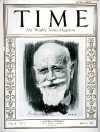 Often called “the maker of modern Greece,” Venizelos was a Greek revolutionary who became a prominent statesman. After leading an assembly to declare the union of Crete with Greece in 1905, he went to Athens and won an extraordinary popular following. During his first term as Greek premier, he completed the revision of the constitution and led Greece through the Balkan Wars, in which its territory and population were doubled. Facing rebellion in 1935, he fled to France. When did he die?
Often called “the maker of modern Greece,” Venizelos was a Greek revolutionary who became a prominent statesman. After leading an assembly to declare the union of Crete with Greece in 1905, he went to Athens and won an extraordinary popular following. During his first term as Greek premier, he completed the revision of the constitution and led Greece through the Balkan Wars, in which its territory and population were doubled. Facing rebellion in 1935, he fled to France. When did he die?  Parker was an American short-story and verse writer who gained an almost legendary reputation for her sardonic wit while serving as drama critic for Vanity Fair and book critic for The New Yorker. She went on to write stage and screen plays and was twice nominated for an Academy Award. In the 1950s, she was blacklisted by Hollywood for her suspected ties to Communism. Parker was a founding member of the Algonquin Round Table, dubbed “The Vicious Circle” by members. What was it?
Parker was an American short-story and verse writer who gained an almost legendary reputation for her sardonic wit while serving as drama critic for Vanity Fair and book critic for The New Yorker. She went on to write stage and screen plays and was twice nominated for an Academy Award. In the 1950s, she was blacklisted by Hollywood for her suspected ties to Communism. Parker was a founding member of the Algonquin Round Table, dubbed “The Vicious Circle” by members. What was it?  Basie was an American jazz pianist and composer who became one of the premier swing bandleaders of his time. After working in dance halls and vaudeville in New York City, Basie moved to Kansas City, a major jazz center, where he formed his own band. Under his leadership, they broadcast from the Reno Club in Kansas City, where a radio announcer dubbed him “Count.” According to one story, the band came up with what signature song while improvising to fill time on the radio show?
Basie was an American jazz pianist and composer who became one of the premier swing bandleaders of his time. After working in dance halls and vaudeville in New York City, Basie moved to Kansas City, a major jazz center, where he formed his own band. Under his leadership, they broadcast from the Reno Club in Kansas City, where a radio announcer dubbed him “Count.” According to one story, the band came up with what signature song while improvising to fill time on the radio show? 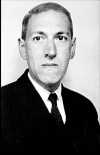 A master of Gothic horror, fantasy, and science fiction, Howard Phillips Lovecraft was an American writer particularly noted for his many nightmarish short stories, most of which originally appeared in Weird Tales and other pulp magazines. Some of his best-known tales are part of the Cthulhu Mythos series, in which he invents an entire mythology of earthly origins, gods, and hideous otherworldly creatures. Many of Lovecraft’s stories mention the Necronomicon, which is what?
A master of Gothic horror, fantasy, and science fiction, Howard Phillips Lovecraft was an American writer particularly noted for his many nightmarish short stories, most of which originally appeared in Weird Tales and other pulp magazines. Some of his best-known tales are part of the Cthulhu Mythos series, in which he invents an entire mythology of earthly origins, gods, and hideous otherworldly creatures. Many of Lovecraft’s stories mention the Necronomicon, which is what?  Arguably the most important figure in 20th-century fashion, Chanel founded her first house of couture in 1913. Within five years, her innovative use of jersey fabric and accessories was attracting wealthy patrons. Her nonconformist designs stressed simplicity and comfort and revolutionized the fashion industry. The financial basis of her empire was her Chanel No. 5 perfume, introduced in 1922 and still popular today. What essential women’s fashion staple was first popularized by Chanel?
Arguably the most important figure in 20th-century fashion, Chanel founded her first house of couture in 1913. Within five years, her innovative use of jersey fabric and accessories was attracting wealthy patrons. Her nonconformist designs stressed simplicity and comfort and revolutionized the fashion industry. The financial basis of her empire was her Chanel No. 5 perfume, introduced in 1922 and still popular today. What essential women’s fashion staple was first popularized by Chanel? 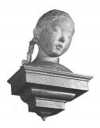 The first English child born in the Americas, Dare began her life in the colony of Roanoke in what is now the state of North Carolina. Strangely, the colony soon disappeared, and what became of Dare and the other colonists remains a mystery. In the 400 years since, Dare has become a prominent figure in American mythology and folklore. To many, she represents concepts like innocence and hope. Others use her name as a rallying cry for bigotry and sexism. How do historians know about her birth?
The first English child born in the Americas, Dare began her life in the colony of Roanoke in what is now the state of North Carolina. Strangely, the colony soon disappeared, and what became of Dare and the other colonists remains a mystery. In the 400 years since, Dare has become a prominent figure in American mythology and folklore. To many, she represents concepts like innocence and hope. Others use her name as a rallying cry for bigotry and sexism. How do historians know about her birth?